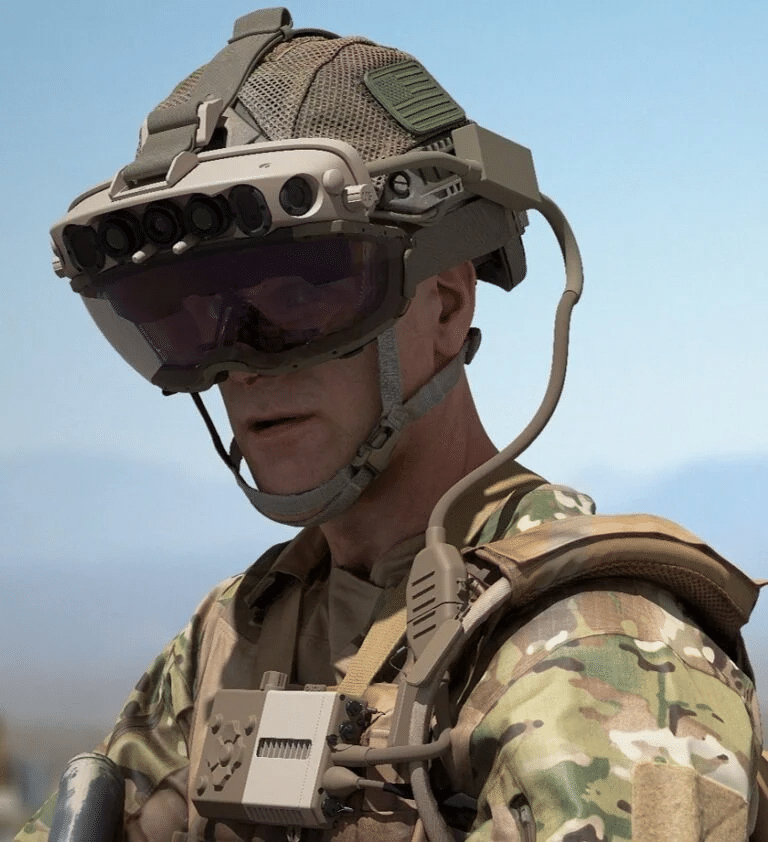The US Congress rejected further US Army orders of HoloLens IVAS after field tests revealed issues.
The decade-scale Integrated Visual Augmentation System (IVAS) program aims to equip US Army soldiers with AR helmets to enhance situational awareness. IVAS is a heavily modified variant of HoloLens 2, more ruggedized and housing many more sensors. The field of view was significantly increased from roughly 40°x30° to 80°x40°. That’s wider than any other known see-through AR headset on the market. But field testing reportedly revealed “mission-affecting physical impairments” including headaches, eyestrain and nausea. Previous evaluations found reliability issues, with “essential functions” sometimes failing.
The first batch of 5000 headsets is already being delivered, but Bloomberg reports Congress has blocked the next $400 million order of 6900 units after reviewing the test results. The existing batch of 5000 will reportedly be used for training.
The US Army has now awarded Microsoft a $125 million contract for a new 1.2 version with a “a lower profile Heads-Up Display with distributed counterweight for improved user interface and comfort” as well as software changes to improve reliability and reduce power draw.

Reported potential use cases for IVAS include:
- overlaying icons on friendly units, objectives, threats, and points of interest
- built-in night vision & thermal view modes
- live picture-in-picture feeds from drones, including the Soldier Borne Sensor (SBS) personal drone
- simulated weapons & enemies for training exercises
- scanning nearby people for high temperature
- facial recognition for hostage rescue situations
The Army was also testing integrations with vehicles, such as soldiers being able to see-through the walls of the armored vehicle carrying them, so on dismounting they’ll be situationally aware.
Some Microsoft employees had protested providing technology for the military, but CEO Satya Nadella responded by saying “We made a principled decision that we’re not going to withhold technology from institutions that we have elected in democracies to protect the freedoms we enjoy”.
Microsoft also plans to release a new version of its regular non-militarized HoloLens, though “not yet“. It’s unclear how, if at all, that new headset relates to IVAS 1.2.
- SEO Powered Content & PR Distribution. Get Amplified Today.
- Platoblockchain. Web3 Metaverse Intelligence. Knowledge Amplified. Access Here.
- Source: https://uploadvr.com/congress-rejects-more-ivas-but-new-version/
- 1
- 7
- a
- Able
- After
- aims
- All
- already
- and
- AR
- AR Headset
- Army
- awarded
- awareness
- being
- blocked
- Bloomberg
- carrying
- cases
- Changes
- CNN
- Congress
- contract
- decision
- delivered
- Display
- distributed
- Drones
- elected
- employees
- enemies
- evaluations
- existing
- field
- First
- found
- friendly
- from
- further
- going
- headaches
- headsets
- heavily
- High
- HoloLens
- hololens 2
- housing
- How
- HTML
- HTTPS
- improve
- improved
- in
- include
- Including
- institutions
- integrated
- integrations
- Interface
- issues
- ivas
- known
- made
- many
- Market
- max-width
- Microsoft
- Military
- million
- modified
- more
- New
- new headset
- next
- night
- objectives
- orders
- Other
- People
- personal
- physical
- plans
- plato
- Plato Data Intelligence
- PlatoData
- points
- potential
- power
- previous
- Profile
- Program
- protect
- providing
- recognition
- reduce
- regular
- release
- reliability
- rescue
- Results
- Revealed
- reviewing
- roughly
- sensors
- significantly
- So
- Software
- such
- system
- Technology
- test
- Testing
- tests
- The
- thermal
- threats
- to
- Training
- units
- us
- us army
- us congress
- use
- User
- User Interface
- Variant
- vehicle
- Vehicles
- version
- View
- vision
- Weapons
- webp
- wider
- will
- Work
- zephyrnet













